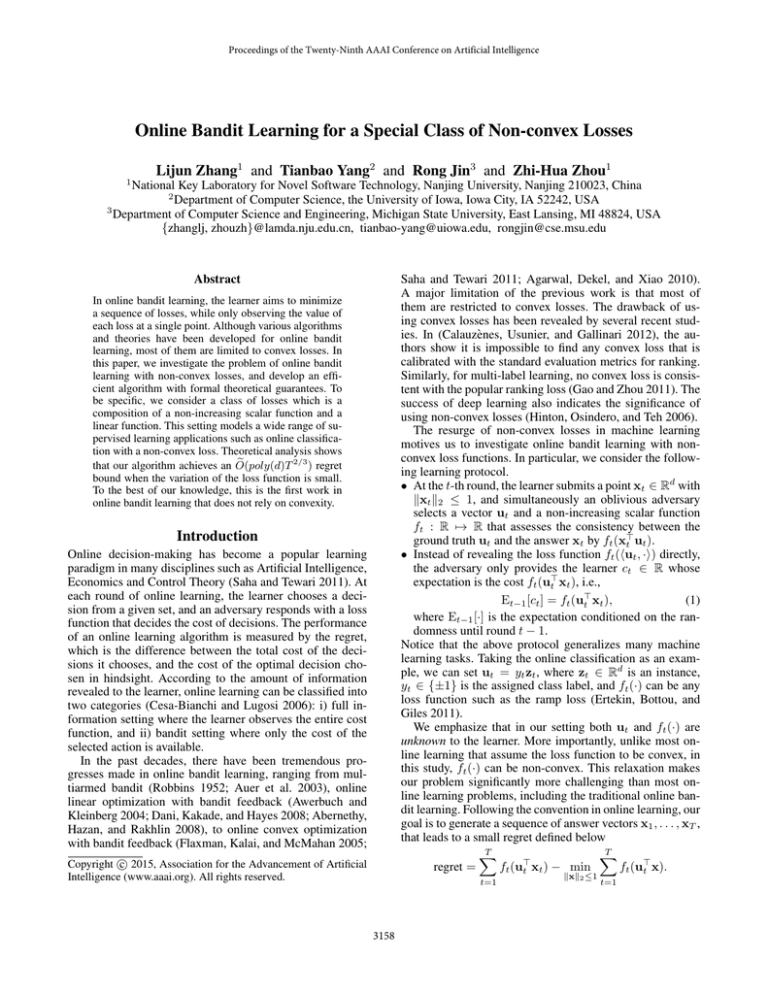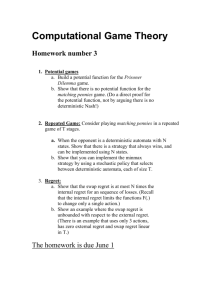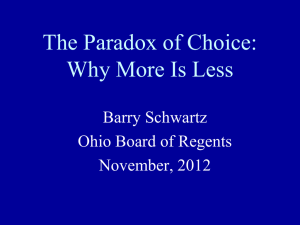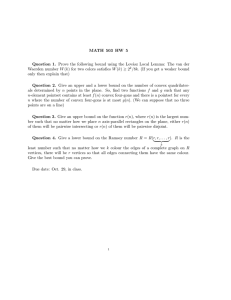
Proceedings of the Twenty-Ninth AAAI Conference on Artificial Intelligence
Online Bandit Learning for a Special Class of Non-convex Losses
Lijun Zhang1 and Tianbao Yang2 and Rong Jin3 and Zhi-Hua Zhou1
1
National Key Laboratory for Novel Software Technology, Nanjing University, Nanjing 210023, China
2
Department of Computer Science, the University of Iowa, Iowa City, IA 52242, USA
3
Department of Computer Science and Engineering, Michigan State University, East Lansing, MI 48824, USA
{zhanglj, zhouzh}@lamda.nju.edu.cn, tianbao-yang@uiowa.edu, rongjin@cse.msu.edu
Abstract
Saha and Tewari 2011; Agarwal, Dekel, and Xiao 2010).
A major limitation of the previous work is that most of
them are restricted to convex losses. The drawback of using convex losses has been revealed by several recent studies. In (Calauzènes, Usunier, and Gallinari 2012), the authors show it is impossible to find any convex loss that is
calibrated with the standard evaluation metrics for ranking.
Similarly, for multi-label learning, no convex loss is consistent with the popular ranking loss (Gao and Zhou 2011). The
success of deep learning also indicates the significance of
using non-convex losses (Hinton, Osindero, and Teh 2006).
The resurge of non-convex losses in machine learning
motives us to investigate online bandit learning with nonconvex loss functions. In particular, we consider the following learning protocol.
• At the t-th round, the learner submits a point xt ∈ Rd with
kxt k2 ≤ 1, and simultaneously an oblivious adversary
selects a vector ut and a non-increasing scalar function
ft : R 7→ R that assesses the consistency between the
ground truth ut and the answer xt by ft (x>
t ut ).
• Instead of revealing the loss function ft (hut , ·i) directly,
the adversary only provides the learner ct ∈ R whose
expectation is the cost ft (u>
t xt ), i.e.,
Et−1 [ct ] = ft (u>
(1)
t xt ),
where Et−1 [·] is the expectation conditioned on the randomness until round t − 1.
Notice that the above protocol generalizes many machine
learning tasks. Taking the online classification as an example, we can set ut = yt zt , where zt ∈ Rd is an instance,
yt ∈ {±1} is the assigned class label, and ft (·) can be any
loss function such as the ramp loss (Ertekin, Bottou, and
Giles 2011).
We emphasize that in our setting both ut and ft (·) are
unknown to the learner. More importantly, unlike most online learning that assume the loss function to be convex, in
this study, ft (·) can be non-convex. This relaxation makes
our problem significantly more challenging than most online learning problems, including the traditional online bandit learning. Following the convention in online learning, our
goal is to generate a sequence of answer vectors x1 , . . . , xT ,
that leads to a small regret defined below
T
T
X
X
regret =
ft (u>
x
)
−
min
ft (u>
t
t
t x).
In online bandit learning, the learner aims to minimize
a sequence of losses, while only observing the value of
each loss at a single point. Although various algorithms
and theories have been developed for online bandit
learning, most of them are limited to convex losses. In
this paper, we investigate the problem of online bandit
learning with non-convex losses, and develop an efficient algorithm with formal theoretical guarantees. To
be specific, we consider a class of losses which is a
composition of a non-increasing scalar function and a
linear function. This setting models a wide range of supervised learning applications such as online classification with a non-convex loss. Theoretical analysis shows
2/3
e
that our algorithm achieves an O(poly(d)T
) regret
bound when the variation of the loss function is small.
To the best of our knowledge, this is the first work in
online bandit learning that does not rely on convexity.
Introduction
Online decision-making has become a popular learning
paradigm in many disciplines such as Artificial Intelligence,
Economics and Control Theory (Saha and Tewari 2011). At
each round of online learning, the learner chooses a decision from a given set, and an adversary responds with a loss
function that decides the cost of decisions. The performance
of an online learning algorithm is measured by the regret,
which is the difference between the total cost of the decisions it chooses, and the cost of the optimal decision chosen in hindsight. According to the amount of information
revealed to the learner, online learning can be classified into
two categories (Cesa-Bianchi and Lugosi 2006): i) full information setting where the learner observes the entire cost
function, and ii) bandit setting where only the cost of the
selected action is available.
In the past decades, there have been tremendous progresses made in online bandit learning, ranging from multiarmed bandit (Robbins 1952; Auer et al. 2003), online
linear optimization with bandit feedback (Awerbuch and
Kleinberg 2004; Dani, Kakade, and Hayes 2008; Abernethy,
Hazan, and Rakhlin 2008), to online convex optimization
with bandit feedback (Flaxman, Kalai, and McMahan 2005;
c 2015, Association for the Advancement of Artificial
Copyright Intelligence (www.aaai.org). All rights reserved.
t=1
3158
kxk2 ≤1
t=1
We present a simple algorithm for online bandit learning with non-convex losses. It is computationally efficient
and achieves a non-trivial regret bound under appropriate
conditions. Our approach follows the standard explorationexploitation framework for bandit learning (Awerbuch and
Kleinberg 2004; McMahan and Blum 2004). In an exploration round, the algorithm submits a random vector in order
to obtain an unbiased estimate of ut , and updates the current solution based on the bandit feedback. In an exploitation round, it submits the current solution in order to incur a
small loss. Under the assumption that ft (·) is non-increasing
and Lipschitz continuous, we are able to bound the regret by
the number of iterations and the variation of the target vectors {ut }Tt=1 . To be specific, the regret bound takes the form
√
2/3
e
O(poly(d)T
+ T VT ),1 where VT is the variation of vectors u1 , . . . , uT . Thus, the proposed algorithm achieves an
2/3
e
O((poly(d)T
) regret bound if VT ≤ O(T 1/3 ).
and Proutiere 2014), the regret could be further improved.
The online linear optimization problem with bandit feedback was first introduced by Awerbuch and Kleinberg (2004)
who obtained a O(d3/5 T 2/3 ) regret bound against an oblivious adversary. Later, McMahan and Blum (2004) achieved
an O(poly(d)T 3/4 ) regret bound against an adaptive adversary. In (Dani, Kakade, and Hayes 2008; Abernethy,
Hazan, and Rakhlin
2008), the regret bound was improved
√
to O(poly(d) T ), where the dependence on T is optimal (Bubeck, Cesa-Bianchi, and Kakade 2012).
Online Non-convex Optimization
Several heuristic approaches have been developed for online learning with non-convex loss in the full information
setting, such as the online version of the concave-convex
procedure (Ertekin, Bottou, and Giles 2011; Gasso et al.
2011). However, none of them are equipped with a formal
regret bound. One exception is the online submodular
√ minimization (Hazan and Kale 2012) that achieves O( dT ) and
O(dT 2/3 ) regret bounds in the full information and bandit
settings, respectively. But these algorithms rely on the specific property of submodular function (i.e., the Lovász extension is convex), and thus cannot be applied to the problem
considered here.
Related Work
In this section, we briefly review the related work in online
convex and non-convex optimizations.
Online Convex Optimization
In the full information setting, online convex optimization has been extensively studied (Kivinen, Smola, and
Williamson 2002; Zhang et al. 2013). Zinkevich (2003)
shows that a simple
online gradient descent algorithm
√
achieves an O( T ) regret bound for convex and Lipschitz continuous functions. When the loss function is
strongly convex, the regret bound can be improved to
O(log
√ T ) (Hazan, Agarwal, and Kale 2007). Both the
O( T ) and O(log T ) regrets bounds, for convex and
strongly convex loss functions respectively, are known to be
minimax optimal (Abernethy et al. 2009).
Compared to the full information setting, the regret bound
for the bandit setting is usually worse and has an explicit dependence on the dimensionality d. The current best-known
e 2/3 T 2/3 ), O(d2/3 T 2/3 ),
regret bounds
are O(dT 3/4 ), O(d
√
and O(d T ) for convex, convex-and-smooth, strongly convex, and strongly-convex-and-smooth functions, respectively (Flaxman, Kalai, and McMahan 2005; Saha and
Tewari 2011; Agarwal, Dekel, and Xiao 2010). Notice that
when the learner is allowed to query the loss function at multiple points, the regret can be improved to match its counterpart in the full information setting (Agarwal, Dekel, and
Xiao 2010).
In the bandit setting, there are two special cases that are
well-studied: multiarmed bandit and online linear optimization with bandit feedback. In the first problem, we assume
there are K arms, and a gambler pulls one of them to receive a reward in each round. Auer et al. (2003)
√ prove that
e
the gambler’s regret can be bounded by O( KT ), which
is optimal up to logarithmic factors (Audibert and Bubeck
2009). Furthermore, if the reward function has some structural properties, such as Lipschitz (Magureanu, Combes,
An Efficient Algorithm for Online Bandit
Learning
We first describe the proposed algorithm for online bandit
learning with non-convex losses, and then state its theoretical guarantees.
The Algorithm
Algorithm 1 summarizes the key steps of the proposed algorithm. We maintain two sequences of vectors during the
learning process: the answer vectors xt and the auxiliary
vector wt . We initialize the answer vector x1 to be a random normalized vector, and the auxiliary vector w1 to be 0.
At each iteration t, we generate a Bernoulli random variable
Zt with Pr(Zt = 1) = η to determine whether to explore
or exploit. When Zt = 0, we will simply submit the answer
vector xt as the solution, and make no update. When Zt = 1,
we will first compute a normalized Gaussian random vector
vt /kvt k2 and submit it as the answer. Based on the received
feedback ct , we update the auxiliary vector and the answer
vector by
wt+1 = wt −
wt+1
ct
vt and xt+1 =
.
kvt k2
kwt+1 k2
We note that for the sake of simplicity, Algorithm 1 follows the early studies of online bandit learning that separate the exploration steps from the exploitation steps (Awerbuch and Kleinberg 2004; McMahan and Blum 2004). This
is different from the more recent strategy for explorationexploitation (Flaxman, Kalai, and McMahan 2005; Abernethy, Hazan, and Rakhlin 2008) that usually combines exploration and exploitation into a single step by adding random perturbation to the submitted solutions. We will exam-
1
e notation to hide constant factors as well as polyWe use the O
logarithmic factors in d and T .
3159
where δ(·) is the Dirac delta function. When d ≥ 2, we
have (Cho 2009)
(
d−3
Γ( d
2)
√ (1 − z 2 ) 2 , for − 1 < z < 1
Γ( d−1
π
h(z) =
(3)
)
2
0,
otherwise
Algorithm 1 An Efficient Algorithm for Online Bandit
Learning
Input: step size η and number of trials
T
1: Set η = T −1/3
2: Initialize x1 as any random normalized vector and w1 =
0
3: for t = 1, 2, . . . , T do
4:
Sample binary random variable Zt with Pr(Zt =
1) = η.
5:
Sample a random vector vt from an Gaussian distribution N (0, Id )
6:
Submit the solution x0t = Zt kvvttk2 + (1 − Zt )xt
7:
Receive ct from the adversary
Zt ct
vt
8:
Update the auxiliary vector wt+1 = wt − kv
t k2
9:
Update the answer vector xt+1 = wt+1 /kwt+1 k2
10: end for
where Γ(·) is the Gamma function. The following proposition, which is inspired by the recent developments in
one-bit compressive sensing (Plan and Vershynin 2013;
Zhang, Yi, and Jin 2014), provides the key observation for
our analysis.
Proposition 1. We have
Z t ct
Et−1 −
vt = γηu, t = 1, . . . , T
kvt k2
where
Z
(4)
1
γ=−
f (z)h(z)z d z.
(5)
−1
From our assumption that f (·) is non-increasing, it is easy
to verify that γ ≥ 0. We note that γ will have a strong dependence on d. Generally speaking, we have γ = poly(d−1 ).
For instance, when f (z) = −z, we have γ = E[z 2 ] =
d−1 (Cho 2009).
Proposition 1 shows that in the exploration step, our algorithm is able to find an unbiased estimate of u, up to a
scaling factor. Based on this observation, we obtain the following regret bound.
ine in the future the second strategy for online bandit learning with non-convex losses.
Finally, we would like to point out that following the idea
of discretizing the decision space (Dani, Kakade, and Hayes
2008), our problem can be reduced to the multiarmed bandit
and solved by existing methods (Auer et al. 2003). However,
this strategy is inefficient because the number of arms is exponential in the dimensionality d, and the regret bound may
also have a high dependence on d. In contrast, our algorithm
is very efficient and the regret bound only has a polynomial
dependence on d.
Theorem 1. Assume
!3
r
T (d + 1)
T ≥ max e,
log
log T
.
δ
The Main Results
Besides the basic assumption in (1), we further make the
following assumptions in our analysis.
• ft (·) is non-increasing and L-Lipschitz continuous.
• Both ct and ft (·) are upper bounded by a constant B. That
is,
sup |ct | ≤ B, and
sup
t∈[T ],kxk2 ≤1
t∈[T ]
|ft (u>
t x)| ≤ B.
Set η = T −1/3 in Algorithm 1. Then, with a probability 1 −
δ − τ , we have
regret ≤
1
4B log + 1 + 4B
τ
(2)
3L
γ
!
2
T (d + 1)
log
+ 1 T 3.
δ
r
To simplify the presentation, we assume the horizon T is
known so that we can choose η = T −1/3 in the algorithm.
This limitation could be addressed by the well-known “doubling trick” (Cesa-Bianchi and Lugosi 2006). Theorem 1 ime −1 T 2/3 ) regret bound,
plies our algorithm achieves an O(γ
which is even better than the regret bound in the general
online convex optimization with bandit feedback (Flaxman,
Kalai, and McMahan 2005). From the discussion in (Dani
and Hayes 2006; Abernethy, Hazan, and Rakhlin 2008), we
also know that Ω(T 2/3 ) regret bound is unavoidable if any
algorithm ignores the feedback received during exploitation.
We finally note that although the regret bound in Theorem 1
does not have an explicit dependence on d, its dependence
on d comes from γ.
We now extend the simple case to a slightly more complicated scenario where a different loss function is used. In this
case, we have the following proposition.
• The target vectors ut ’s are of unit length, i.e., kut k2 = 1,
t = 1, . . . T .
• The adversary is oblivious, meaning that both ut ’s and
ft ’s are fixed.
As a starting point, we first analyze the regret bound for the
simplest case when all the target vectors are the same, and
then move to the general case.
Regret Bound for a Single Target Vector We first consider the simplest case when u1 = u2 = · · · = uT = u and
f1 = f2 = · · · = fT = f .
Define h(z) as the probability density function (PDF) of
the inner product of random unit vectors in Rd . When d = 1,
it is easy to verify
h(z) =
(6)
1
(δ(z − 1) + δ(z + 1)),
2
3160
When
VT ≤ O(T 1/3 ), the additional
p the total variation
√
term T (VT + 12 VT ) is on the order of T 2/3 . Furthermore, if we assume a small variation for each iteration, that
is, Vt ≤ O(t1/3 ) for all t ∈ [T ], each kūt k2 will be lower
bounded by some constant,2 and thus 1/ρT is upper bounded
e −1 T 2/3 )
by some constant. As a result, we still have an O(γ
regret bound. On the other hand, the regret bound becomes
trivial when VT = Ω(T ), which is significantly worse than
the previous results on variation based regret bound (Hazan
and Kale 2010). This is because we are dealing with nonconvex optimizations and therefore the gradient does not
provide an universal lower bound for the entire function.
Thus, we cannot utilize the analysis for convex functions,
but only rely on the assumption that ft (·) is non-increasing
and Lipschitz continuous. Finally, it is straightforward to extend the above result to the case when a different loss function is used, by introducing γ̄ defined in Theorem 2.
Proposition 2. We have
Zt ct
vt = γt ηu, t = 1, . . . , T
Et−1 −
kvt k2
where
Z
1
γt = −
ft (z)h(z)z d z.
−1
Following almost the same analysis for Theorem 1, we
obtain the following theorem to bound the regret.
Theorem 2. Suppose T and η satisfy the conditions in Theorem 1. With a probability 1 − δ − τ , we have
regret ≤
1
4B log + 1 + 4B
τ
3L
γ̄
!
2
T (d + 1)
+1 T3
log
δ
r
where γ̄ = min γt .
t∈[T ]
Analysis
The only difference between Theorems 2 and 1 is that γ
in Theorem 1 is replaced with γ̄, the smallest one among
{γt }Tt=1 .
We here present the proofs of main theorems. The omitted
proofs are provided in the supplementary material.
Regret Bound for the General Case We now consider the
more general case where each ut is a different vector. Let ūt
be the average of vectors u1 , . . . , ut , i.e.,
ūt =
1
t
t
X
Proof of Theorem 1
Under the assumption u1 = u2 = · · · = uT = u, we have
regret
ut .
i=1
=
Similar to Theorem 1, we have the following regret bound
for the general case when a single loss function is used.
Theorem 3. Suppose T and η satisfy the conditions in Theorem 1. Then, with a probability 1 − δ − τ , we have
T
X
1
regret ≤4B log + 1 + 2L
kut − ūt−1 k2
τ
t=2
!
r
2
T (d + 1)
3L
log
+ 4B
+ 1 T 3,
γρT
δ
(2)
≤2B
t
T
X
t=1
t=1
| {z }
|
f (u> xt ) − min f (u> x) .
T 2
t=1
∆1 ≤ 2E[∆1 ] + 2 log
From (7) and Theorem 3, we have
q
p
1
regret ≤4B log + 1 + 2L T (VT + 12 VT )
τ
!
r
2
3L
T (d + 1)
+ 4B
log
+1 T3
γρT
δ
VT =
T X
kxk≤1
{z
∆2
}
Then, we discuss how to bound ∆1 and ∆2 .
According to the Multiplicative Chernoff Bound (Angluin
and Valiant 1979) provided in the supplementary, we have
with a probability at least 1 − τ
(7)
where
Zt +
∆1
t
T 2
t=1
T
X
(8)
kxk≤1
t=1
t∈[T ]
t−1 2
kxk≤1
> T
X
u vt
>
Zt f
=
− f (u xt )
kvt k2
t=1
T X
+
f (u> xt ) − min f (u> x)
To bound the second term in the regret bound, we need
the following inequality (Hazan and Kale 2010)
v
u T
T
T
uX
X
X
2
ku − ū k .
ku −ū k2 ≤
ku −ū k2 +12t
t
f (u> x0t ) − T min f (u> x)
t=1
where γ is defined in (5) and ρT = min kūt k2 .
t=2
T
X
1
1
= 2ηT + 2 log .
τ
τ
(9)
To bound ∆2 , we introduce the vector-valued martingaledifference sequence
δi = −
Zi ci
vi − γηu, i = 1, . . . , T.
kvi k2
(10)
The following lemma follows immediately from the Freedman’s inequality for matrix martingales (Tropp 2011).
2
We can prove it by contradiction. Suppose kūt k2 ≤ c, then
we must have Vt ≥ (1 − c)2 t = Θ(t).
kut − ūT k22 .
t=1
3161
Proof of Lemma 1
Lemma 1. With a probability 1−δ, we have, for any t ∈ [T ],
t
X
δi ≤ ρt (δ)
i=1
We first state the Freedman’s inequality for matrix martingales below.
2
Theorem 4. (Tropp 2011, Corollary 1.3) Let k · k be the
spectral norm of a matrix, which returns its largest singular
value. Consider a matrix martingale {Yi : i = 0, 1, 2, . . . }
whose values are matrices with dimension d1 ×d2 . Let {Xi :
i = 1, 2, 3, . . .} be the difference sequence, and assume that
the difference sequence is uniformly bounded:
where
r
4B
T (d + 1)
T (d + 1)
log
+ B 2ηt log
.
3
δ
δ
From the assumption that f (·) is non-increasing and LLipschitz continuous, we have the following lemma.
Lemma 2. We have
>
f (x>
t u) − min f (x u)
kxk≤1
(
2B,
if t = 1;
P
t−1 ≤
2L
i=1 δi , otherwise.
γη(t−1) ρt (δ) =
kXi k ≤ R almost surely i = 1, 2, 3, . . . .
Define two predictable quadratic variation processes for this
martingale:
2
Wcol,t :=
Based on Lemmas 1 and 2, we have with a probability at
least 1 − δ,
T
2L X ρt−1 (δ)
∆2 ≤2B +
γη t=2 t − 1
T −1
8LB
T (d + 1) X 1
log
3γη
δ
t
t=1
s
T −1
2LB 2
T (d + 1) X 1
√
+
log
γ
η
δ
t
t=1
Ei−1 [Xi Xi> ],
i=1
Wrow,t :=
t
X
Ei−1 [Xi> Xi ], t = 1, 2, 3, . . . .
i=1
Then, for all γ ≥ 0 and σ 2 > 0,
Pr kYt k ≥ γ and max{kWcol,t k, kWrow,t k} ≤ σ 2
γ 2 /2
.
≤ (d1 + d2 ) exp − 2
σ + Rγ/3
2
/2
By setting δ = exp − σ2γ+Rγ/3
, Theorem 4 implies that
with a probability at most δ,
r
2R
d1 + d2
d1 + d2
kYt k ≥
log
+ 2σ 2 log
and
3
δ
δ
max{kWcol,t k, kWrow,t k} ≤ σ 2 .
=2B +
(6)
t
X
(11)
6LB
T (d + 1)
log
log T
γη
δ
s
4LB 2T
T (d + 1)
+
log
,
γ
η
δ
≤2B +
where we use the following inequalities
Z T
T
X
1
1
≤1 +
dt = 1 + log t|T1 = log T + 1, and
t
t
t=1
t=1
Z T
T
X
√
√
1
1
√ ≤1+
√ dt = 1 + 2 t|T1 = 2 T − 1.
t
t
t=1
t=1
We then introduce several facts that will be used in our
analysis. Let ξ be a random vector. Based on Jensen’s inequality, we have
kE[ξ]k2 ≤ E[kξk]2 .
Combining (8), (9) and (11), we have with a probability
at least 1 − τ − δ,
regret
1
6LB
T (d + 1)
≤4B ηT + log + 1 +
log
log T
τ
γη
δ
s
4LB 2T
T (d + 1)
+
log
γ
η
δ
2
1
6LB 1
T (d + 1)
=4B T 3 + log + 1 +
T 3 log
log T
τ
γ
δ
r
6LB
T (d + 1) 2
+
log
T3
γ
δ
r
(6)
2
1
12LB
T (d + 1) 2
3
≤4B T + log + 1 +
log
T 3.
τ
γ
δ
(12)
From the property of positive semidefinite (PSD) matrices,
we have
E (ξ − E[ξ])(ξ − E[ξ])> = E[ξξ > ] − E[ξ]E[ξ]> (13)
=α> E[ξξ > ] − E[ξ]E[ξ]> α
≤α> E[ξξ > ]α ≤ kE[ξξ> ]k,
where α is the largest eigenvector of the PSD matrix
E[ξξ > ] − E[ξ]E[ξ]> . Furthermore, it is easy to verify that
E (ξ − E[ξ])> (ξ − E[ξ])
(14)
=E[ξ > ξ] − E[ξ]> E[ξ] ≤ E[ξ > ξ].
Notice that the spectral norm of a vector is its `2 -norm.
3162
We bound the `2 -norm of the δi as follows
Zi ci
kδi k2 = −
vi − γηu
kvi k2
2
Zi ci ≤
kvi k2 vi + kγηuk2
2
(4), (12) Zi ci
Z i ci +
E
vi v
≤ i−1
i
kvi k2 kvi k2 2
2
According to the procedure in Algorithm 1, we have
t−1
t−1
X
X
Zi ci
(10)
wt =
−
vi = γη(t − 1)u +
δi .
kvi k2
i=1
i=1
Then, we have
t−1 X
kwt − γη(t − 1)uk2 ≤ δi i=1
2
t−1 X
1
w
t
δi .
⇔
γη(t − 1) − u ≤ γη(t − 1) 2
(2)
≤2B, i = 1, . . . , T.
i=1
We then bound the two predictable quadratic variation
processes as follows
t
X
> Ei−1 [δi δi ]
i=1
t
"
> #
X
Zi ci vi
Z i ci v i
=
Ei−1
+ γηu
+ γηu
kv
k
kv
k
i
2
i
2
i=1
"
#
t
> X
Z i ci v i
Zi ci vi
≤
+ γηu
+ γηu
Ei−1
kv
k
kv
k
i 2
i 2
i=1
t 2
(4), (13) X (2)
Ei−1 Zi ci vi vi> ≤ ηB 2 t,
≤
2
kvi k2
i=1
t
X
>
Ei−1 [δi δi ]
i=1
"
> #
t
X
Z i ci
Z i ci
vi + γηu
vi + γηu
=
Ei−1
kvi k2
kvi k2
i=1
(4), (14)
≤
t
X
2
Following a simple geometric argument, we have
t−1 X
wt
2
δi kwt k − u ≤ γη(t − 1) 2
i=1
2
t−1 X 2L
(15)
>
>
⇒f (xt u) − min f (x u) ≤
δi .
γη(t − 1) kxk≤1
i=1
2
Proof of Theorem 2
In this case, we define the vector-valued martingaledifference sequence as
Zi ci
δi = −
vi − γi ηu, i = 1, . . . , T.
kvi k2
It is easy to verify that Lemma 1 still holds and Lemma 2
become the following one.
Lemma 3. We have
>
ft (x>
t u) − min ft (x u) ≤
kxk≤1
(
2B,
if t = 1;
P
t−1 2L
i=1 δi , otherwise.
γ̄η(t−1) (2)
Ei−1 Zi c2i ≤ ηB 2 t.
2
The rest proof is the same as that for Theorem 1.
i=1
Then, based on Theorem 4, for each t ∈ [T ], we have with a
probability at least 1 − δ
r
t
X
d+1
4B
d+1
δi ≤
log
+ B 2ηt log
.
3
δ
δ
i=1
Conclusion and Future Work
In this paper, we study the problem of online bandit learning with non-convex losses, and assume the loss function
is a composition of a non-increasing scalar function and a
linear function. Following the idea of exploration and exploitation, we develop an efficient algorithm which achieves
2/3
e
O(poly(d)T
) regret bound under appropriate conditions.
One limitation of the current work is that the regret bound
only holds against an oblivious adversary. In the future, we
will investigate how to extend our results to the adaptive adversary. There are also many open problems for bandit learning with non-convex losses, such as under what condition
there exists a Hannan-consistent algorithm and what is the
lower bound. We will leave these questions for future investigations.
2
We complete the proof by taking the union bound over t =
1, . . . , T .
Proof of Lemma 2
When t = 1, it is clear that
(2)
>
f (x>
1 u) − min f (x u) ≤ 2B.
kxk≤1
In the following, we discuss the case when t ≥ 2. From our
assumption that f (·) is a non-increasing function, we have
>
>
>
f (x>
t u) − min f (x u) = f (xt u) − f (u u).
Acknowledgments
kxk≤1
Since f (·) is L-Lipschitz continuous, we further have
>
>
>
f (x>
t u) − f (u u) ≤L|xt u − u u|
wt
≤ Lkxt − uk2 = L − u
.
kwt k
This research was supported by NSFC (61333014,
61321491), the Collaborative Innovation Center of Novel
Software Technology and Industrialization, NSF (IIS1251031), ARO (W911NF-11-1-0383), and Baidu Fund
(181315PO5760).
(15)
2
3163
References
Gao, W., and Zhou, Z.-H. 2011. On the consistency of multilabel learning. In Proceedings of the 24th Annual Conference on Learning Theory, 341–358.
Gasso, G.; Pappaioannou, A.; Spivak, M.; and Bottou, L.
2011. Batch and online learning algorithms for nonconvex
neyman-pearson classification. ACM Transactions on Intelligent Systems and Technology 2(3):28:1–28:19.
Hazan, E.; Agarwal, A.; and Kale, S. 2007. Logarithmic
regret algorithms for online convex optimization. Machine
Learning 69(2-3):169–192.
Hazan, E., and Kale, S. 2010. Extracting certainty from
uncertainty: regret bounded by variation in costs. Machine
Learning 80(2-3):165–188.
Hazan, E., and Kale, S. 2012. Online submodular minimization. In Journal of Machine Learning Research, volume 13,
2903–2922.
Hinton, G. E.; Osindero, S.; and Teh, Y.-W. 2006. A fast
learning algorithm for deep belief nets. Neural Computation
18(7):1527–1554.
Kivinen, J.; Smola, A. J.; and Williamson, R. C. 2002. Online learning with kernels. In Advances in Neural Information Processing Systems 14, 785–792.
Magureanu, S.; Combes, R.; and Proutiere, A. 2014. Lipschitz bandits: Regret lower bounds and optimal algorithms.
In Proceedings of the 27th Conference on Learning Theory,
975–999.
McMahan, H. B., and Blum, A. 2004. Online geometric optimization in the bandit setting against an adaptive adversary.
In Proceedings of the 17th Annual Conference on Learning
Theory, 109–123.
Plan, Y., and Vershynin, R. 2013. Robust 1-bit compressed
sensing and sparse logistic regression: A convex programming approach. IEEE Transactions on Information Theory
59(1):482–494.
Robbins, H. 1952. Some aspects of the sequential design of
experiments. Bulletin of the American Mathematical Society
58(5):527–535.
Saha, A., and Tewari, A. 2011. Improved regret guarantees for online smooth convex optimization with bandit feedback. In Proceedings of the 14th International Conference
on Artificial Intelligence and Statistics, 636–642.
Tropp, J. A. 2011. Freedman’s inequality for matrix martingales. Electronic Communications in Probability 16:262–
270.
Zhang, L.; Yi, J.; Jin, R.; Lin, M.; and He, X. 2013. Online
kernel learning with a near optimal sparsity bound. In Proceedings of the 30th International Conference on Machine
Learning (ICML).
Zhang, L.; Yi, J.; and Jin, R. 2014. Efficient algorithms
for robust one-bit compressive sensing. In Proceedings
of the 31st International Conference on Machine Learning
(ICML).
Zinkevich, M. 2003. Online convex programming and generalized infinitesimal gradient ascent. In Proceedings of the
20th International Conference on Machine Learning, 928–
936.
Abernethy, J.; Agarwal, A.; Bartlett, P. L.; and Rakhlin, A.
2009. A stochastic view of optimal regret through minimax
duality. In Proceedings of the 22nd Annual Conference on
Learning Theory.
Abernethy, J.; Hazan, E.; and Rakhlin, A. 2008. Competing in the dark: An efficient algorithm for bandit linear optimization. In Proceedings of the 21st Annual Conference on
Learning, 263–274.
Agarwal, A.; Dekel, O.; and Xiao, L. 2010. Optimal
algorithms for online convex optimization with multi-point
bandit feedback. In Proceedings of the 23rd Annual Conference on Learning, 28–40.
Angluin, D., and Valiant, L. 1979. Fast probabilistic
algorithms for hamiltonian circuits and matchings. Journal
of Computer and System Sciences 18(2):155–193.
Audibert, J.-Y., and Bubeck, S. 2009. Minimax policies
for adversarial and stochastic bandits. In Proceedings of the
22nd Annual Conference on Learning Theory.
Auer, P.; Cesa-Bianchi, N.; Freund, Y.; and Schapire, R. E.
2003. The nonstochastic multiarmed bandit problem. SIAM
Journal on Computing 32(1):48–77.
Awerbuch, B., and Kleinberg, R. D. 2004. Adaptive routing
with end-to-end feedback: Distributed learning and geometric approaches. In Proceedings of the 36th Annual ACM
Symposium on Theory of Computing, 45–53.
Bubeck, S.; Cesa-Bianchi, N.; and Kakade, S. M. 2012. Towards minimax policies for online linear optimization with
bandit feedback. In Proceedings of the 25th Annual Conference on Learning Theory.
Calauzènes, C.; Usunier, N.; and Gallinari, P. 2012. On
the (non-)existence of convex, calibrated surrogate losses for
ranking. In Advances in Neural Information Processing Systems 25, 197–205.
Cesa-Bianchi, N., and Lugosi, G. 2006. Prediction, Learning, and Games. Cambridge University Press.
Cho, E. 2009. Inner product of random vectors. International Journal of Pure and Applied Mathematics 56(2):217–
221.
Dani, V., and Hayes, T. P. 2006. Robbing the bandit: Less
regret in online geometric optimization against an adaptive
adversary. In Proceedings of the 17th Annual ACM-SIAM
Symposium on Discrete Algorithm, 937–943.
Dani, V.; Kakade, S. M.; and Hayes, T. P. 2008. The price
of bandit information for online optimization. In Advances
in Neural Information Processing Systems 20, 345–352.
Ertekin, S.; Bottou, L.; and Giles, C. L. 2011. Nonconvex
online support vector machines. IEEE Transactions on Pattern Analysis and Machine Intelligence 33(2):368–381.
Flaxman, A. D.; Kalai, A. T.; and McMahan, H. B. 2005.
Online convex optimization in the bandit setting: Gradient
descent without a gradient. In Proceedings of the 16th Annual ACM-SIAM Symposium on Discrete Algorithms, 385–
394.
3164









